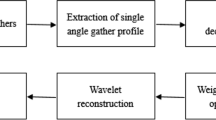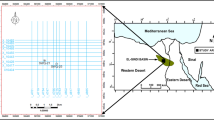Abstract
Stacking is one crucial seismic data processing technique that gives a composite record made by combining traces from different shot records. The quality of stacking dramatical affects the performance of many seismic data processing tasks. The conventional equal-weight stacking method is the average of all traces in the pre-stack CMP gather, improving the signal-to-noise ratio (SNR) but reducing resolution. Most weighted stacking algorithms aim to enhance image quality by the increased SNR; however, these algorithms do not consider the resolution. Therefore, we proposed a weighted stacking algorithm with resolution enhancement, which is regarded as having maximum bandwidth and dominant frequency. Based on the genetic algorithm (GA), we calculated the stacking weights in common midpoint (CMP), or common-reflection-point (CRP) gathers. Then, we presented a weighted stacking approach to obtain the resolution-enhancement stacked data. The proposed method can obtain the resolution-enhancement stacked data by the single-trace spectrum constraint without wavelet estimation. Applications to synthetic and field seismic datasets demonstrate that compared with the traditional stacking method, the proposed method can improve the stacking resolution better, which is beneficial for subsequent interpretation.














Similar content being viewed by others
Availability of data and materials
The data that support the findings of this study are available from the corresponding author upon reasonable request.
References
Baykulov M, Gajewski D (2009) Pre-stack seismic data enhancement with partial common-reflection-surface (CRS) stack. Geophysics 74(3):V49–V58
Boyd S, Parikh N, Chu E (2011) Distributed optimization and statistical learning via the alternating direction method of multipliers. Found Trends Machine Learn 3(1):1–122
Buzlukov V, Landa E (2013) Imaging improvement by pre-stack signal enhancement. Geophys Prospect 61(6-Challenges of Seismic Imaging and Inversion Devoted to Goldin):1150–1158
Chai X, Wang S, Yuan S (2014) Sparse reflectivity inversion for nonstationary seismic data. Geophysics 79(3):V93–V105
Cheng Q, Chen R, Li TH (1996) Simultaneous wavelet estimation and deconvolution of reflection seismic signals. IEEE Trans Geosci Remote Sens 34(2):377–384
Chui CK (1992) An introduction to wavelets. Academic Press, Cambridge, Massachusetts
Donoho DL (2006) Compressed sensing. IEEE Trans Inf Theory 52(4):1289–1306
Elumalai K, Yadav DK, Manpura AK, Patney RK (2020) Stacking seismic data based on ramanujan sums. IEEE Geosci Remote Sens Lett 17(9):1633–1636
Finnila AB, Gomez MA, Sebenik C, Stenson C, Doll JD (1994) Quantum annealing: a new method for minimizing multidimensional functions. Chem Phys Lett 219(5–6):343–348
Fomel S (2002) Applications of plane-wave destruction filters. Geophysics 67(6):1946–1960
Geyer CJ (1992) Practical markov chain monte carlo. Statistical Science, 473–483
Harik GR, Lobo FG, Goldberg DE (1999) The compact genetic algorithm. IEEE Trans Evol Comput 3(4):287–297
Houck CR, Joines JA, Kay MG (1995) A genetic algorithm for function optimization: a Matlab implementation. NCSUIE-TR 95(09):1–10
Howard LT, Stephen CB, John FM (1979) Deconvolution with the L1 norm. Geophysics 44(1):39–52
Lee MW (1986) Spectral whitening in the frequency domain. Department of the Interior, US Geological Survey, Reston, Virginia
Li Q, Gao J (2014) Application of seismic data stacking in time-frequency domain. IEEE Geosci Remote Sens Lett 11(9):1484–1488
Liu G, Fomel S, Jin L, Chen X (2009) Stacking seismic data using local correlation. Geophysics 74(3):V43–V48
Loo GV, Saelens X, Gurp MV, Macfarlane M, Martin SJ, Vandenabeele P (2002) The role of mitochondrial factors in apoptosis: a russian roulette with more than one bullet. Cell Death Differ 9(10):1031
Margrave GF, Lamoureux MP, Henley DC (2011) Gabor deconvolution: estimating reflectivity by nonstationary deconvolution of seismic data. Geophysics 76(3):W15–W30
Maurya SP, Singh KH, Singh NP (2018) Reservoir characterization using post-stack seismic inversion techniques based on real coded genetic algorithm. J Geophys 39(2)
Nawab S, Quatieri T, Lim J (1983) Signal reconstruction from short-time fourier transform magnitude. IEEE Trans Acoust Speech Signal Process 31(4):986–998
Neelamani R, Dickens TA, Deffenbaugh M (1949) Stack-and-denoise: a new method to stack seismic datasets. SEG Tech Program Expand Abs 25(1).
Padhi A, Mallick S (2013) Accurate estimation of density from the inversion of multicomponent pre-stack seismic waveform data using a nondominated sorting genetic algorithm. Lead Edge 32(1):94–98
Peacock KL, Treitel S (1969) Predictive deconvolution: theory and practice. Geophysics 34(2):155–169
Rashed MA (2008) Smart stacking: a new CMP stacking technique for seismic data. Leading Edge 27(4):462–467
Robinson EA, Treitel S (1967) Principles of digital wiener filtering. Geophys Prospect 15(3):311–332
Sanchis C, Hanssen A (2011) Enhanced local correlation stacking method. Geophysics 76(3):V33–V45
Sattari H (2017) High-resolution seismic complex trace analysis by adaptive fast sparse S-transform. Geophysics 82(1):V51–V67
Schimmel M, Paulssen H (1997) Noise reduction and detection of weak, coherent signals through phase-weighted stacks. Geophys J Int 130(2):497–505
Schoenberger M (1996) Optimum weighted stack for multiple suppression. Geophysics 61(3):891–901
Stephen B, Lin X, Almir M (2003) Subgradient methods
Trickett S (2007) Maximum-likelihood-estimation stacking. In: SEG technical program expanded abstracts. pp 2640–2643
Van Laarhoven PJ, Aarts EH (1987) Simulated annealing: theory and applications. Springer, Netherlands
Vose MD (1999) The simple genetic algorithm: foundations and theory. MIT press, Cambridge, Mass
Wu J, Bai M (2017) Fast principal component analysis for stacking seismic data. J Geophys Eng 15(2):295
Xie J, Chen W, Zhang D, Zu S, Chen Y (2017) Application of principal component analysis in weighted stacking of seismic data. IEEE Geosci Remote Sens Lett 14(8):1213–1217
Yilmaz Ö (2001) Seismic data analysis: processing, inversion, and interpretation of seismic data. Society of Exploration Geophysicists
Author information
Authors and Affiliations
Corresponding author
Ethics declarations
Conflict of interest
On behalf of all authors, the corresponding author states that there is no conflict of interest.
Additional information
Edited by Dr. Mostafa Naghizadeh (ASSOCIATE EDITOR) / Prof. Gabriela Fernández Viejo (CO-EDITOR-IN-CHIEF).
Rights and permissions
Springer Nature or its licensor (e.g. a society or other partner) holds exclusive rights to this article under a publishing agreement with the author(s) or other rightsholder(s); author self-archiving of the accepted manuscript version of this article is solely governed by the terms of such publishing agreement and applicable law.
About this article
Cite this article
Sun, Y., Chen, S. & Cao, S. Resolution-oriented weighted stacking based on global optimization algorithm. Acta Geophys. 71, 2125–2135 (2023). https://doi.org/10.1007/s11600-023-01024-5
Received:
Accepted:
Published:
Issue Date:
DOI: https://doi.org/10.1007/s11600-023-01024-5




